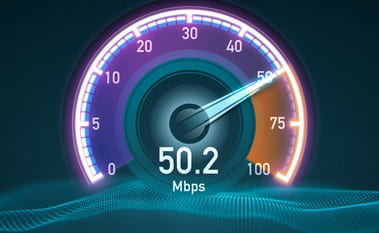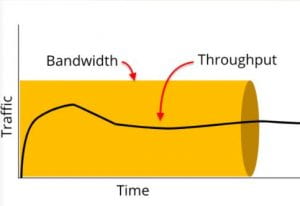Home Internet Study
The Coalition for School Networking (CoSN) obtained a grant from the Chan Zukerberg Initiative (CZI) to conduct a study to determine home internet connectivity requirements to support student learning in today’s education environment.

About
The Study
School districts across the country supported an unprecedented numbers of students with remote or hybrid learning models heavily dependent on access to quality internet access at home. An established national standard for access necessary to support learners at home does not exist. CoSN has the opportunity to establish a standard for home connectivity based on actual student usage data and in partnership with school districts.
The study produced data driven analysis of Internet access and broadband connectivity for remote and hybrid learners. This analysis will identify connectivity challenges, equity concerns, and correlation of the impact or influence of connectivity with persistence in remote or hybrid learning environments.
Why is SpeedTest being used to collect data?
Throughput is the actual amount of data to pass from point A to point B in a determined amount of time. Speedtest gathers a large amount of data when a user runs the test. Standard internet speed metrics measured by Speedtest include download and upload speed, latency, jitter, and packet loss.
What school divisions are participating?
|
District Name |
State |
Classification |
|
Ector County ISD |
TX |
Combination |
|
Santa Fe Public Schools |
NM |
Combination |
|
Wake County Public School System |
NC |
Combination |
|
Fauquier County Public Schools |
VA |
Rural |
|
Beaverton School District |
OR |
Suburban |
|
Forest Ridge School District 142 |
IL |
Suburban |
|
Rock Hill Schools York 3 |
SC |
Suburban |
|
St. Charles CUSD 303 |
IL |
Suburban |
|
Aldine ISD |
TX |
Urban |
|
Boston Public Schools |
MA |
Urban |
|
MSD of Wayne Township |
IN |
Urban |
|
San Francisco Unified School District |
CA |
Urban |
|
Hillsborough County Public Schools |
FL |
Urban |
|
Dallas ISD |
TX |
Urban |
|
Los Angeles Unified School District |
CA |
Urban |
What organizations are involved with the study?
- Consortium for School Networking– Lead agency
- Chan Zuckerberg Initiative -Provided grant funds for the project.
- Innive – Technical advisory and implementation
CoSN Educator Advisory Committee
Dr. Tom Ryan, Santa Fe Public Schools CTO, will chair the Advisory Committee
| Name | Organization |
| Kellie Wilks | Ector County ISD |
| Louis McDonald | Fauquier County Public Schools |
| Mark Racine | Boston Public Schools |
| Jeremy Bunkley | Hillsborough County Public Schools |
| Tom Ryan | Santa Fe Public Schools |
| Christine Fox | SETDA |
| TBD | SETDA |
| Andrew Moore | Boulder Valley School District |
| Steve Buettner | Edina Public Schools |
| Mark Finstrom | Highline Public Schools |
| Eileen Belastock | Nausets Schools |
Info
FAQs
What is network throughput?
Throughput is the actual amount of data to pass from point A to point B in a determined amount of time.
Throughput shows its results as an average and uses “data units per time” metrics such as bits per second “bps” or packets per second “pps.”
Although the concept of throughput is similar to bandwidth, they are not the same.
Why is upload speed important?
Download speed represents the speed at which data is transferred from the internet to your computer. Well, the upload speed is the opposite. It’s how fast data moves from your computer to the network. Broadband providers place all their emphasis on download speeds because the vast majority of the stuff you do online involves downloading. Everything from opening a simple web page to streaming Netflix is affected by your download speed. By and large, the faster it is the better your experience will be.
Every time your computer communicates with a website or other online service it does so by uploading packets of data to those services. The amount of data involved is so small that it’s unaffacted by your upload speed. It all happens instantanesouly.
This means that your upload speed is irrelevant for day-to-day web use, which is just as well because it’s usually a lot slower than your download speed. Broadband providers know that downloading is more important, so they configure their system to give that priority.
Where it does matter is when you’re uploading large amounts of data. Uploading one gigabyte (1GB) of images would take around two and a half hours at a 1Mb upload speed, or just 14 minutes at 10Mb upload speed.
When you use video conferencing products like Zoom, your upload speed dictates whether you can broadcast yourself in glorious high definition or will have to settle for a more low-res, pixellated image, whether you have gallery view or speaker, and if you have video and audio on all the time. Zoom can require 1.5Mb to 3Mb upload speed for transmitting in full high definition.
What are the products from the study?
- Standards – Network Throughput standards to support remote learning.
- Executive Summary – Report available to general public discussing remote learning home internet requirements and its impact on equitable education for all.
- Detailed Report – A detailed report available to CoSN members that describes the study’s methodology and provides recommendations for remote learning home internet requirements and its impact on equitable education for all.
- District Dashboard – A Dashboard with analytics that participating Districts can use to assess impact of students with low bandwidth. Districts will only be able to see their own data, but compare their results with the defined standards.
What student data is gathered?
- Student Demographics
- Student Email
- Home Address
- Enrolled School
- Grade
- Equity Factors
- Network Log Data
- Student Email
- Source IP
- Destination Domain
- Bytes Sent
- Bytes Received
- Time Taken
- Online Meeting Data
- Student Email
- Source IP
- Destination Domain
- Bytes Sent
- Bytes Received
- Time Taken
- Ookla Speed Test
- Platform
- Download Kbps
- Upload kbps
- Latency
- Jitter
- Server Name
- ISP Name
- Mile Between
- Postal Code
What security practices are being used?
Extreme care will be taken to protect student privacy. For the broader study, all data will be aggregated and de-identified into student subgroups complying with both State and Federal student privacy laws. All data will be stored in the Google Cloud. Information about Google’s security policy is available for viewing.
In addition, Innive has signed the Virginia Student Privacy Agreement as part of the division’s particpation.

